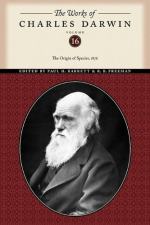
|
| Name: _________________________ | Period: ___________________ |
This test consists of 15 multiple choice questions and 5 short answer questions.
Multiple Choice Questions
1. What other field of science can natural selection be compared to?
(a) Psychology.
(b) Geology.
(c) Biology.
(d) Physics.
2. Concerning the difficulty of defining species, sub-species, and variations, what does Darwin suggest about differences?
(a) They are arbitrary.
(b) Will depend on the species.
(c) There are no differences.
(d) Will depend on the climate.
3. What do some scientists say is the reason that cultivated plants do not produce seeds?
(a) Poor nutrition.
(b) Genetics.
(c) Instinct.
(d) Poor soil.
4. What does Darwin suggest about variation for parts that are NOT specialized?
(a) Less variation.
(b) Eventually stops.
(c) More variation.
(d) Becomes correlational.
5. What results as a climate becomes more hostile?
(a) Better cooperation between species.
(b) More competition.
(c) Fewer species.
(d) Less food.
6. What does natural selection favor in terms of increasing population?
(a) Traits that do not lead to reproduction.
(b) Traits that lead to reproduction.
(c) Traits that lead to strength.
(d) Traits that lead to sterility.
7. What type of work is presented in The Origin of Species?
(a) Biological.
(b) Metaphysical.
(c) Chemical.
(d) Spiritual.
8. What happens when species are inter-bred?
(a) Offspring are stronger.
(b) Variations die out.
(c) Variations increase.
(d) Offspring are weaker.
9. What is the struggle for existence caused by?
(a) Quick reproduction.
(b) Natural selection.
(c) Too many species.
(d) Little food sources.
10. What is the fate of traits that are neither helpful nor unhelpful for survival?
(a) The are bred out of the species.
(b) They are subject to artificial selection.
(c) They are not subject to natural selection.
(d) They are subject to natural selection.
11. What aspect of organisms is not caused by chance?
(a) Variation.
(b) Gender.
(c) Location.
(d) Size.
12. In Chapter 1: Variation Under Domestication, what animal does Darwin give as an example for being perfectly adapted for catching its food?
(a) Beaver.
(b) Bull.
(c) Woodpecker.
(d) Tiger.
13. What would a variety do in order to become a new species?
(a) Reduce in numbers.
(b) Exceed in numbers from the parent species.
(c) Inter-breed.
(d) Migrate.
14. Why does the point of possible starvation for animals occur sooner than for humans?
(a) Humans artificially produce food.
(b) Humans have better hunting tools.
(c) Humans can rely on dietary supplements.
(d) Humans can last longer on less food.
15. What does natural selection say must be true for change to be preserved?
(a) It must be beneficial to the species.
(b) It must be unique.
(c) It must be universal.
(d) It must be genetic.
Short Answer Questions
1. Which of the following tends to live over larger areas?
2. What is one geographical change that affects islands and continents?
3. What can some amount of variation be attributed to?
4. How might one explain the correlation of growth?
5. Which term refers to a type of variation that is seen in most or all groups of organisms?
|
This section contains 463 words (approx. 2 pages at 300 words per page) |

|




